How to avoid that 50 euro meal of stale bread and flat beer.
Stale bread and flat beer, you may scoff. In Paris? Incomprehensible! But… though Paris is known for stellar food, there IS indeed a darker side to eating out in the Capital of Cuisine. Yes, I’m referring to the Paris Tourist Trap Restaurant.
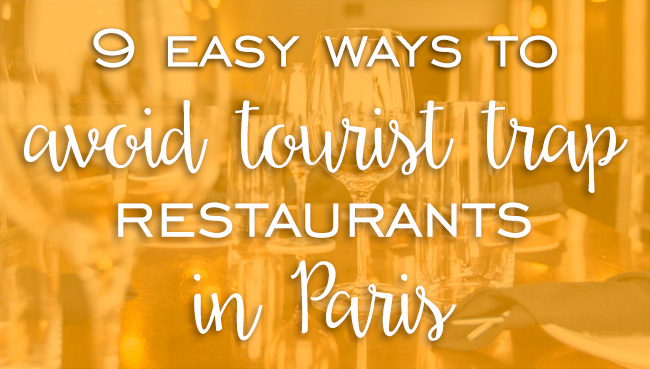
Stale bread and flat beer for 50 euros might be an overstatement, but not by much. Recently a client complained about a “snack” lunch she and her family had just before heading to a tour. For the equivalent of nearly 70 USD (about 55 EUR), she and her family ate: 2 hot dogs, 1 bowl of soup, 2 beers and 1 glass of milk. This will get your blood boiling even more when you remember that Paris is definitely not a city known for its hot dogs, like Chicago.
There are so many better ways to spend that kind of money in Paris… especially in terms of food!
In the past, I’d found myself assuring clients that it’s close to impossible to get a terrible meal in Paris… but honestly? I’m not so sure.
70 USD… 2 hot dogs, 1 bowl of soup, 2 beers and 1 glass of milk.
There’s more that plays into a meal than just the quality of the food: the price, the ambiance, the service, and more. It’s important to keep in mind then, that restaurants or cafes that welcome primarily tourists are bound to take shortcuts when it comes to what they put on their plates. And, they can charge more for it since people are much looser with their expenditures while on vacation.
That’s why when I say “tourist trap restaurants,” what I mean by that is mediocre yet overpriced food. I know very well that is not taking everything into the equation! If it is your dream to have dinner IN the Eiffel Tower, by all means I encourage you to do so. Ambiance is important and I don’t want to discount it… but it is not really the focus of this article.
This article is for those who want to know how to avoid mediocre food at high prices. It’s for those who want to have a more ‘authentic’ Parisian experience in terms of meals. It’s for those who want to explore and discover on their own, but just need a little bit of guidance.
Here are 9 tips that will help you avoid tourist trap restaurants in Paris
1. Walk away from main attractions
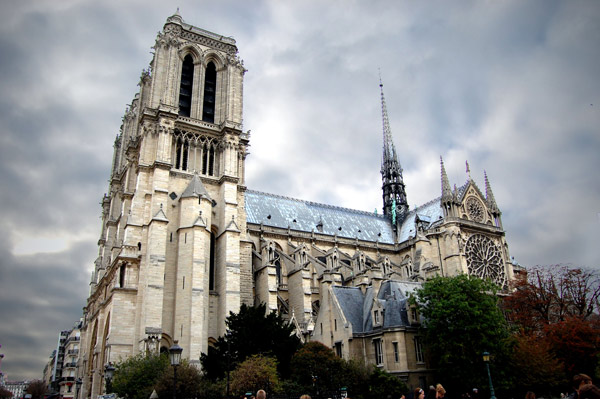
This might seem super intuitive. “Well, duh” you say to yourself. But let me tell you: when you’ve just worn yourself out sightseeing and are getting hangry… it’s more difficult than it seems. Those chairs at that cafe right in front of the Louvre or Notre Dame start to look pretty inviting.
RESIST! Resist the temptation to sit down right by a tourist attraction. Walk as far as you can away from a popular monument or museum. Generally speaking, the further you walk, the better (and better-priced) food you will find.
This all comes down to cost. Those central, key, close-to-monuments locations are very expensive. To be sure to make their rent/mortgage/tax payments, they have to be as profitable as possible. This includes cutting corners on food and drinks, and charging sky-high prices on those food and drinks. Locals may shun a place like that, but when you’re a tourist in a city you don’t know, well, you simply don’t know!
You can’t eat the view.
That’s not to say that the food is terrible at prime locations with a view. However, based on quality and price… more often than not you will be disappointed. Remember: you can’t eat the view, as they say. So if there’s a lovely location, how about having a drink or a coffee to enjoy it, before moving on to another place for food?
So, walk. Walk 10 or 20 minutes, get lost a bit. Then start your search for a restaurant, using the tips below.
2. Avoid hawkers and gimmicks

This one is pretty simple, but we’ve all been sucked in at least once. A restaurant who has a member of staff actively recruiting clients from off the street, is probably not going to give you a great meal. Likewise, a gimmick like a “free” drink or dessert is not your best bet.
Why is this? I’m not really sure, to be honest. My feeling is that if a restaurant has to cajole you to get you inside, there is probably a reason for it. As in: the food isn’t great.
Plus, Parisians themselves aren’t going to be pulled in to a restaurant that way. So if a restaurant is using that technique, they are catering to tourists (see above about cutting corners on food and drink). The best meals you’ll have in Paris are at places who cater to the French. The French and especially Parisians are extremely demanding about what constitutes a good meal. Parisians also have the time (which tourists lack) to ferret the good restaurants from the bad.
3. Listen and look for tourists
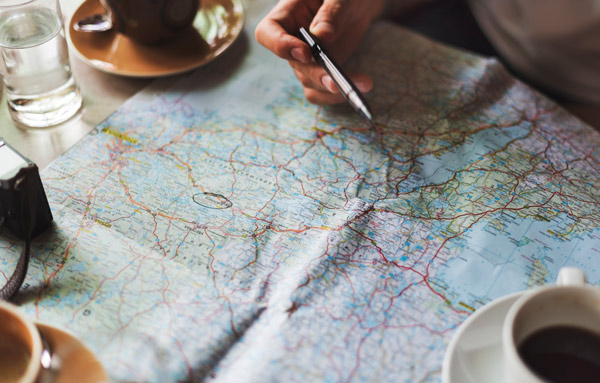
Listen to the languages you hear, both at the restaurant and in the neighborhood around it. (Many Parisian cafes, brasseries, and bistros have terrace seating so this makes listening much easier.) Do you hear a lot of English? More English than French?
Look through the windows of the restaurant. Do you see cameras, maps, and guidebooks on the tables? Do you see the stereotypical hallmarks of a tourist (gym shoes, backpacks, fanny packs, baseball caps…)?
If you answer yes to the questions above, you may want to think twice about choosing that place for a meal.
The best meals you’ll have in Paris are at places who cater to the French.
This is not a judgement on tourists, by the way! I am ALL FOR wearing what makes you comfortable when discovering a new city. Parisians can wear nice shoes and clothes and carry small bags because they’re not walking around outside all day… that’s just the way of the world!
However, you can use those stereotypes to your advantage when trying to avoid a restaurant that caters primarily to tourists.
4. Check the menu
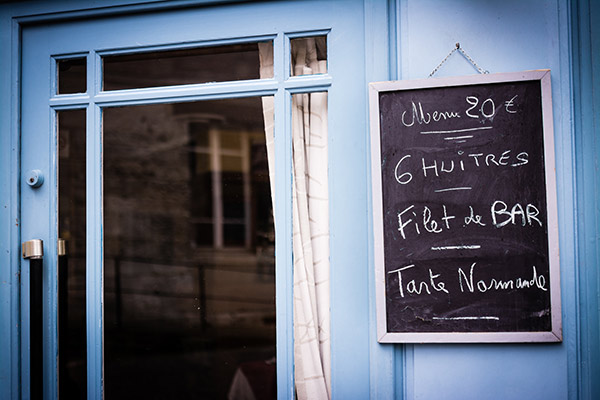
With very few exceptions, Paris restaurants always display their menus (often in the window or door of the restaurant). This is great for checking if they serve something you will want to eat. But menus can also tell you so much more.
First thing to check: is the displayed menu translated into English? If so, you’re at a place that caters to tourists.
I know this seems frustrating. Not everyone learns French before coming to France (and you shouldn’t be expected to!). How are you going to know what the restaurant serves if you can’t understand the menu?
Rest assured that the servers or the chef will be able to translate for you. There are also some pretty nifty smartphone apps to help you translate (check this list of useful apps to get before your trip).
Second thing to check: is the menu huge? If you see more than around 6 options for each course, this is a sign that a lot of the food is kept in the freezer. (Yikes.)
Good Parisian restaurants will have only a handful of options for each course (appetizers, main dish, and dessert). The reason is not only due to smaller restaurant sizes (more on that in a minute) and hence smaller storage space. More importantly, it’s due to the importance of fresh and seasonal ingredients to any chef worth their salt!
Third thing to check: Are there bright flashy signs outside the restaurant? Do they advertise menu prices, or “English Spoken”? If so, you’re once again at a place that caters to tourists.
Again, it’s not that you are 100% going to end up with a bad meal if you go to a restaurant that caters to tourists. But if you want better food at more appropriate prices, you should do your best to avoid places like that.
One more thing to check: many good French restaurants have daily specials: “plat du jour”. Often in North America these are ingredients the restaurant needs to get rid of because they are going bad. However in Paris, the “plat du jour” tends to be the freshest, most season menu options. The chef will go to the market and pick up ingredients that are seasonal, and create a dish based on that. If you see “plat du jour” written on chalkboard, this is usually a good sign.
5. Pay attention to the time.
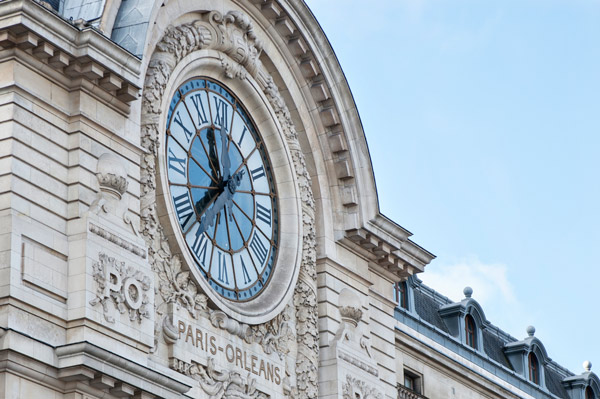
Sometimes travelers (notably North Americans) are surprised at the timing of French meals. Parisians typically eat lunch around 1 or 1:30pm, and dinner around 8:30 or 9pm. Most French restaurants do not even open until 7 or 7:30pm.
So if you see a cafe, brasserie, or bistro that is full of munching clients at 5 or 6pm, this is a place you might want to avoid.
Basically, you’re looking for a place that is pretty empty around noon and 7:30pm. That doesn’t mean it will fill up of course! It’s just one more detail to pay attention to in addition to the rest of these tips.
If you find yourself getting hungry before those typical-dining hours, of course most cafes and brasseries will be open and will have snacks like cheese plates, salads, and croque-monsieurs. But a better bet than that? Find a bakery, grab a sandwich or quiche, and grab a seat on a bench or at one of Paris’ many gorgeous parks! Tip: look for a true bakery, not one that is a combo panini/crepe joint (their bread is usually not made and baked on-site).
6. Listen to locals (but not all of them)

If you’re staying in an apartment rental, ask your host. Seriously, don’t be afraid to pick their brain about restaurants! Going out to eat on a regular basis is actually pretty affordable in Paris – you can get a super high-quality meal for 30 euros, if you know where to look. Many, many Parisians take advantage of that. And most are willing to share their favorite spots if you let them know you’re interested!
If you’re in a hotel, my one piece of advice would be to double check hotel concierge references. This is especially true if the hotel tells you to mention the referral. (They might be getting a kick-back, encouraging them to recommend an address they normally would not.)
People LOVE giving their opinions.
You also have the option to *gasp* strike up conversation with a real life Parisian during your time in Paris! Believe me, I know that this can be super intimidating. But it’s worth it. I find the best way is to sit at a cafe (on the terrace for example) and listen for French. If some Parisians sit down near me, after a while I’ll approach them with a smile and a ‘Bonjour.’ Very important, that bonjour! Then I will ask if they speak English, and if so I’ll just launch right into it. “I want to experience the REAL Paris, so I’m looking for an authentic restaurant for a meal. I’m having trouble finding good restaurants! Do you have a couple favorite restaurants in the city?”
Let me tell you something: People LOVE giving their opinions. Even Parisians. Maybe especially Parisians. This has worked for me on more than a few occasions.
It helps to frame your question in terms of where THEY would go. So rather than just “what are some good restaurants” or “where would you recommend for dinner”, try to get more specific. “Where would YOU go for dinner when you’re tired and just want comfort food” or “where would YOU take a date for dinner on Friday night” will likely get you more authentic responses.
7. Check the restaurant size
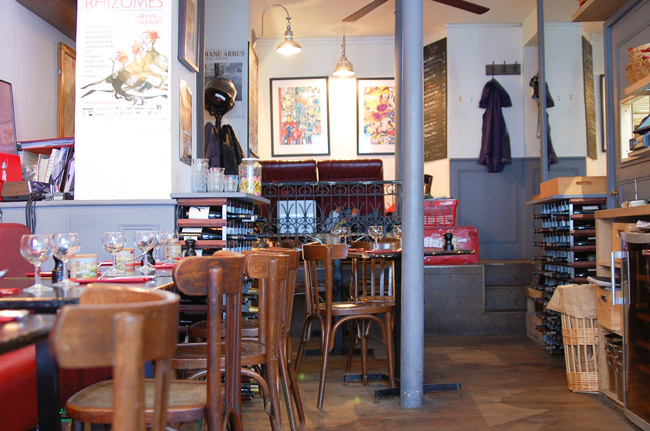
If you’ve been to Paris before, you know that things are smaller here. Apartments, hotel rooms, cars, stores, and yes: restaurants.
Most good French restaurants are small… very small, by North American standards.
So if the restaurant feels tiny, maybe with only 10 tables inside, that’s a good sign.
Large cafes, brasseries, and chain restaurants are designed to accommodate huge rushes of tourists (who are willing to pay far more than they should for food, allowing the restaurant to pay for such a large space!). That’s why you’ll notice generally larger restaurants in neighborhoods by main attractions.
8. Do your research
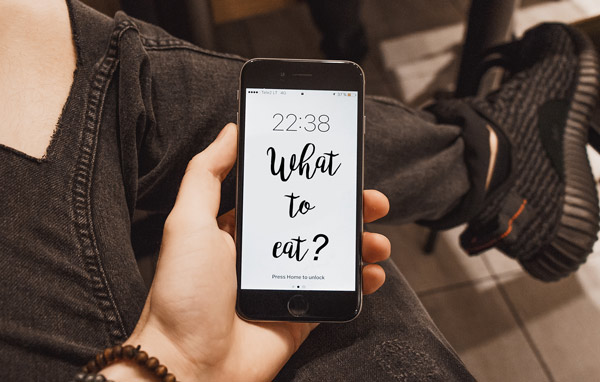
This is one of the last items on this list, because the whole point of the article is to be able to spot a tourist trap restaurant without the internet telling you so! Often meal planning takes a backseat to cultural planning, so doing research ahead of time isn’t always possible. However, especially given the importance of food in France, I would love for you to eat the best possible meals that you can, whether you research beforehand or not!
There are quick apps and websites I would recommend. The first is La Fourchette. This site is more popular among the French for restaurant reviews (and you’ll see based on the large amount of French-language reviews!). There is also an app so that’s useful when you’re on the go.
Le Fooding is another reputable source of restaurant information and reviews. They also have an app!
Another site I would recommend is Paris By Mouth. This site compiles food critic reviews (in English and French) on many restaurants in Paris. They have some curated lists of restaurants depending on what you’re looking for (Haute Cuisine, Quick and Cheap, etc.).
Food blogs are a good source of information as well. But, be careful! There have been quite a few restaurants who find fame through well-known Anglophone food blogs and they completely change (I’m looking at you, Le Verre Volé). It’s not to say this always happens, but be aware and double check recent reviews.
9. Look for window stickers
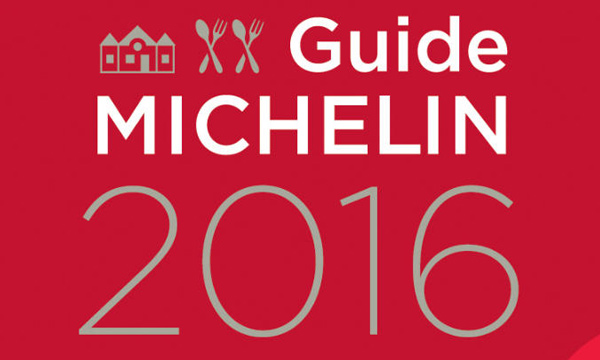
Image: restaurant.michelin.fr
This is last on the list because it’s not super common. However, window stickers for French food guides can be helpful.
The stickers you should look out for are Michelin and Gault & Millau. Those are two very important restaurant guides in France. Michelin you’ve probably heard of before (that’s where those “Michelin-starred” restaurant designations come from!). Gault & Millau is a newer concept restaurant guide that puts heavy importance on quality of ingredients and a return to fundamental flavors of ingredients.

Image: gaultmillau.fr
If you see either of these stickers, it means you’re in good hands! They’re not the bible of course but your chances of eating better in those restaurants skyrockets.
What do you think?
Do you have any other tips on avoiding tourist trap restaurants? Let us know in the comments, so we can ALL eat better!

I like using trip advisor … in the states it’s never let me down … do you suggest using it in Paris ?
Hi Alicia, thanks for reading! We definitely recommend using TripAdvisor in Paris 🙂 The Fork is also a great option!
Great ideas! Thanks and see you soon:)
Thanks Ruby – can’t wait to see you soon in Paris! 🙂
Thank you so much!!!! I am totally overwhelmed trying to figure out my trip in May!
Happy to help, Sandra!
Thank you so much for these tips!
You’re very welcome, Jolene! Thanks for reading 🙂